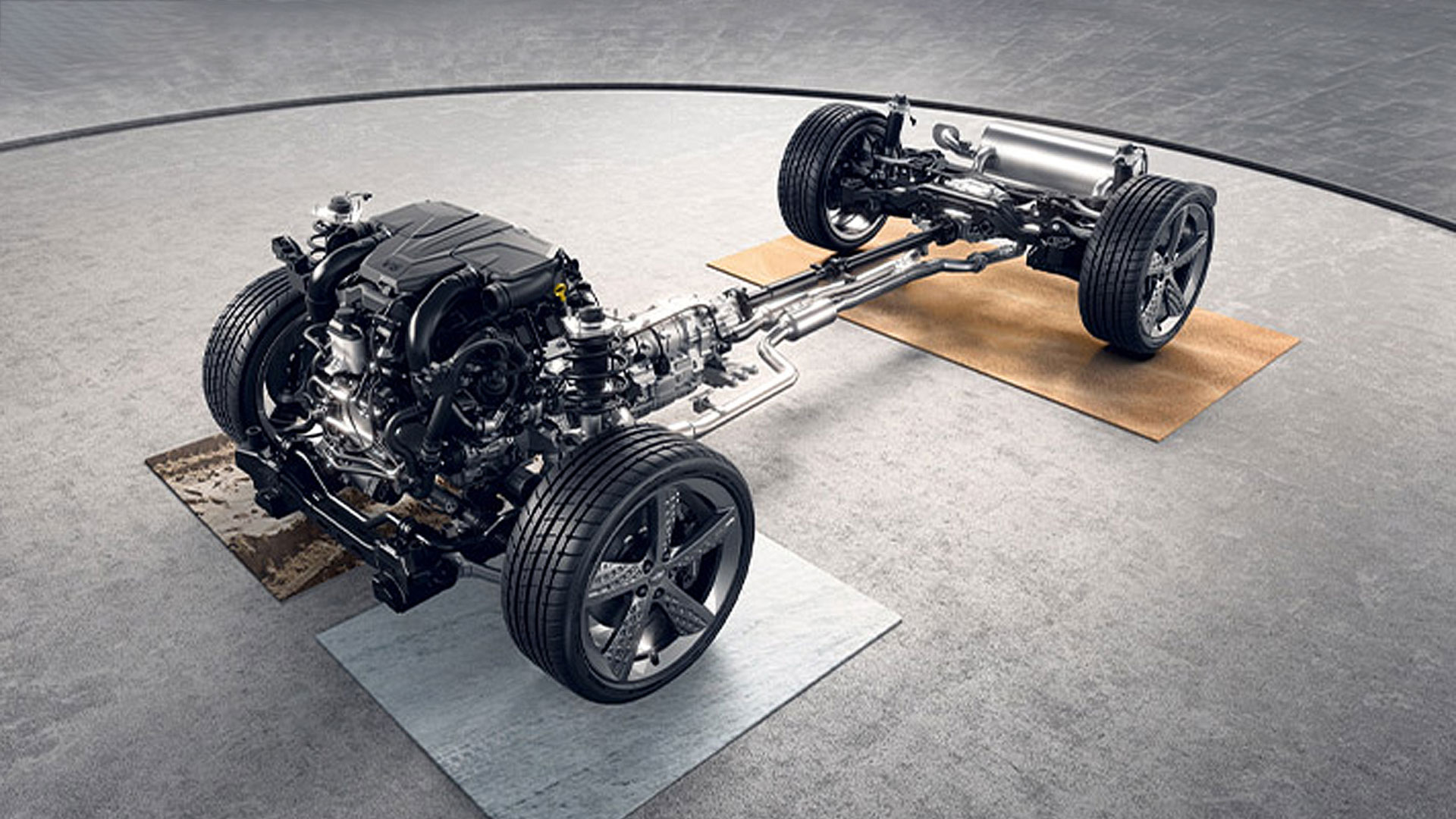
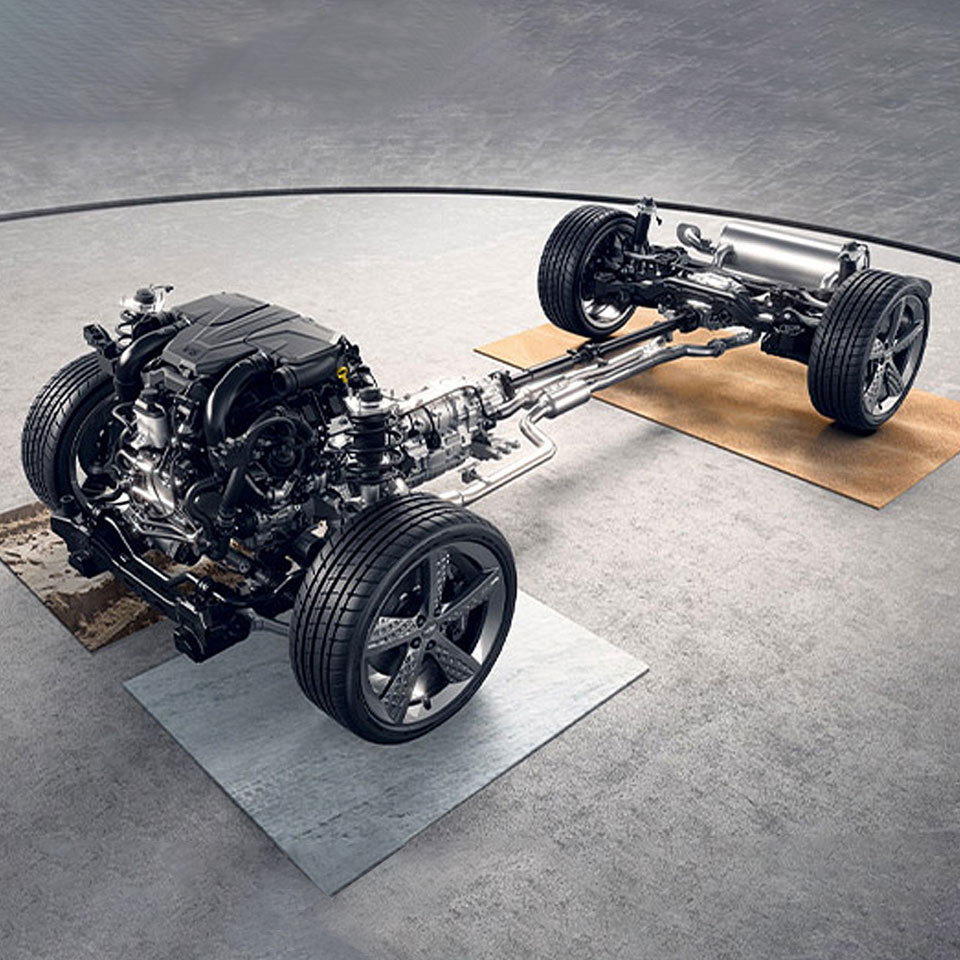


Most premium cars use rear-wheel drive. The biggest reason is the improved ride comfort and driving performance. In a conventional all-wheel-drive vehicle, the front wheels are responsible for both driving and steering. Therefore, the load on the front wheel increases, and the steering performance also deteriorates. On the other hand, a rear-wheel-drive vehicle is advantageous in setting an ideal front and rear weight distribution because some of the driving-related parts are located behind the body. In addition, the driving performance is more stable and agile because the front wheel is responsible for steering while the rear wheel is responsible for driving only. It is also true that rear-wheel drive is advantageous in starting and accelerating compared to front-wheel-drive due to the dynamic load placed on the rear when the vehicle accelerates from a regular road surface.
However, the story is different when a rear-wheel-drive car encounters a slippery snowy road. In particular, it is the most vulnerable uphill covered with snow. In the all-wheel-drive method, the front wheels with a concentrated center of gravity are responsible for driving, so even a little more grip can be secured on slippery road surfaces. In addition, since the front wheel is used to guide the vehicle body, there is less chance that the vehicle body shakes side to side. On hilly roads in snow, the tire's insufficient traction is compensated for by the driving position and the load applied to the front of the body such as the engine and drivetrain.
However, in the rear-wheel-drive method, the load applied to the rear wheel through which the driving force is transmitted is relatively small compared to the front-wheel-drive method. In addition, if the wheels spin on snowy roads, the vehicle cannot accelerate properly. Therefore, the dynamic load on the rear wheels that is carried backward during the acceleration on the dry road surface cannot be obtained. Therefore, no matter how much the latest technology is used to transmit driving power, the tire is inevitably difficult to go uphill and spin around.
In addition, the body of rear-wheel-drive vehicle is less stable, and there is a limit to stabilizing the body due to the separation of the drive shaft (rear wheel) and the steering shaft (front wheel). Because power is not transmitted to the front wheel, which is the steering shaft, it is difficult to turn the sliding car in the normal direction of travel. This is the reason why rear-wheel-drive cars were unable to drive normally in various places in downtown Seoul due to sudden heavy snowfall in early January, and even left on the road sometimes. In addition, many of the high-end brands' rear-wheel-drive cars are equipped with summer tires that have a sharp drop in friction on snowy roads, making this situation even worse.
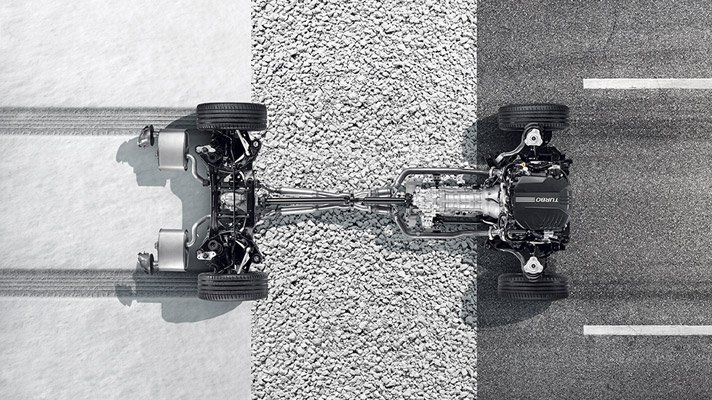
The latest electronic all-wheel-drive system applied by Genesis and other car brands maintains optimal driving performance and high fuel efficiency by transmitting relatively large amounts of driving power to the rear wheels when driving on dry roads. However, when it encounters a slippery road surface like a snowy road, it actively distributes the driving power to the front and rear to increase driving stability. All of this is done so quickly that the driver cannot detect it. Thanks to this, you can enjoy the agility of the rear-wheel-drive and the stability of the four-wheel-drive at the same time.
In particular, for SUV models such as GV70 and GV80, terrain mode optimized for rough road driving is applied. In addition, an electronic differential limiting device 'e-LSD (Electronic-Limited Slip Differential)' that precisely distributes the left and right driving power of the rear wheel corresponding to the drive shaft is added. In addition, the terrain mode of the GV70 and GV80 operates by comprehensively controlling the engine control unit (ECU), transmission control unit (TCU), and traction control system (TCS). The terrain mode, in which various systems move organically, consists of three modes: mud, sand, and snow, among which snow mode can maximize driving stability on snowy roads in winter.
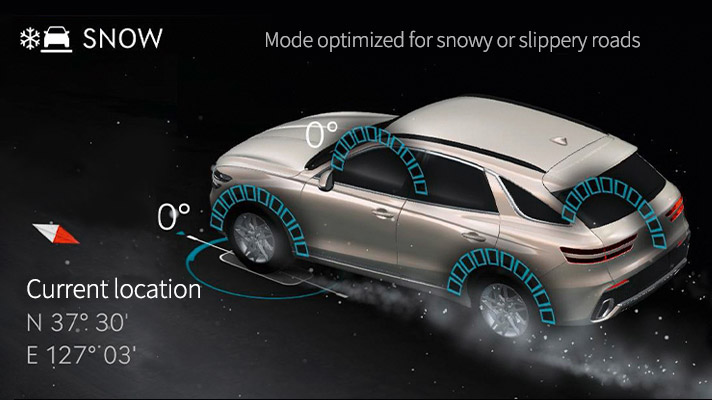
Snow mode, for example, finely controls the engine, transmission, and four-wheel-drive system so that it does not transmit too much force to the wheels and does not slip when running on a road with slippery surfaces like snow. First, it changes the control method so that the engine can smoothly create torque. Even if you press the accelerator pedal with the same force, it slowly increases the engine speed so that too much force doesn't get transmitted. When starting in snow mode, the transmission also uses the second gear instead of the first one. This is because the strong transmission of power in the lower gear is more likely to cause the wheel to idle in the snow. For the same reason, in order to use the highest gear possible, the system shifts the gear more quickly so that the power is carefully transmitted. In addition, more power is sent to the front wheels than when driving on dry roads, creating conditions in which the traction of the four wheels can be utilized to the maximum.
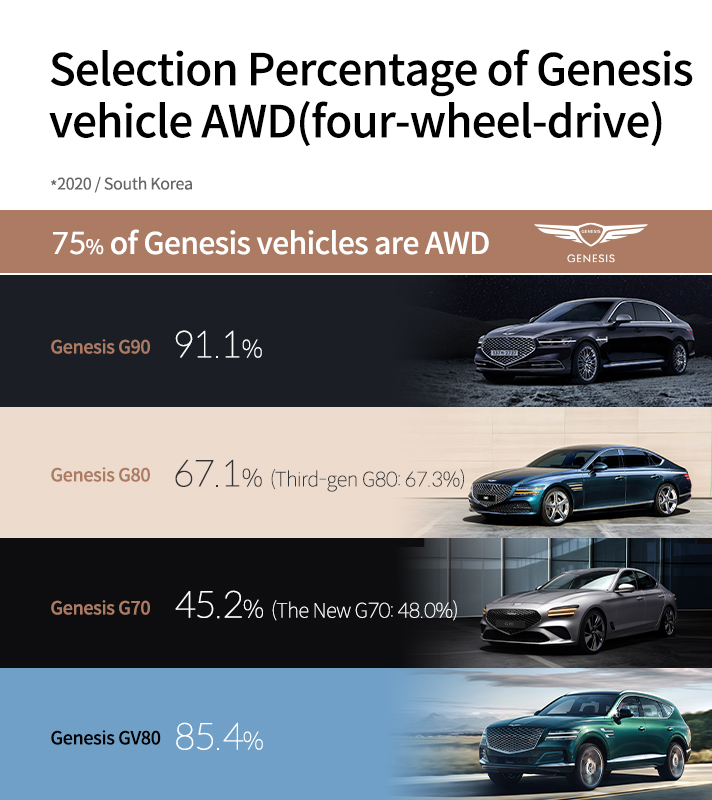
This is the reason why more customers choose AWD (All Wheel Drive) option when buying Genesis. In fact, based on sales volume in 2020, 45.2% of the Genesis G70, which is a sporty sedan, was four-wheel-drive. In the case of The New G70, launched in October last year, the number gets a bit higher; 48% of buyers chose four-wheel drive.
Genesis' four-wheel drive selection ratio increases rapidly as it moves toward higher models. Of the G80 sold in 2020 alone, 67.1% were four-wheel drive. The percentage of the 4WD model among the second-generation G80 sold until last February was 61.9%, but the percentage of 4WD among the third-generation released last March increased to 67.3%. The Genesis brand's flagship model G90's 4WD purchase rate in 2020 reached a whopping 91.1%. The story was the same among SUV models. As of 2020, the GV80's 4WD reached 85.4%, indicating that most buyers prefer the 4WD option.
In particular, the average proportion of all Genesis brands sold last year was 75%. However, considering the fact that the ratio of 4-wheel-drive selection in the southern regions where it rarely snows is rare, the selection rate in the central region including the metropolitan area exceeds 80%. It is also the reason why there were fewer Genesis cars than many other rear-wheel-drive cars abandoned on the roads in the metropolitan area in early January.
*Above is based on the South Korean market
In addition to the aforementioned driving performance, there is one more reason buyers choose the four-wheel-drive option when purchasing the Genesis. That is, you can freely choose the four-wheel-drive option no matter what kind of Genesis you buy through the personalized order system 'Your Genesis'.
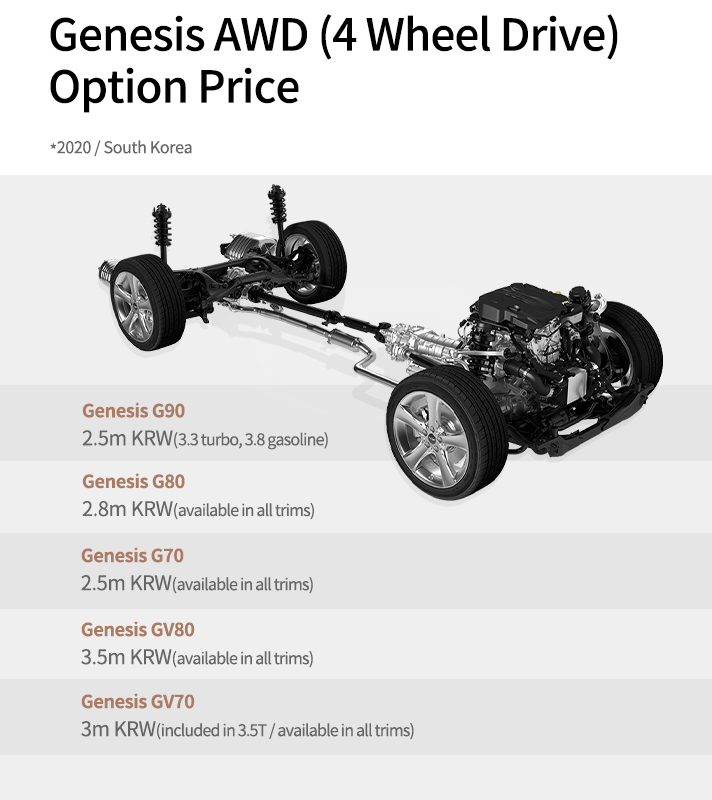
Genesis is also reasonably priced for its four-wheel-drive option compared to other brands. This is a part that differs greatly from having to purchase the highest trim in other premium brands, increasing the price inevitably to have the four-wheel-drive option. What's more, the four-wheel-drive option of some models is usually included in packages, making it difficult to take it alone.
In fact, the price of the four-wheel-drive option of the G70 and G90 sedans is 2.5 million KRW, and the G80 is 2.8 million KRW. The four-wheel-drive prices of the SUVs GV70 and GV80 are 3 million KRW and 3.5 million KRW, respectively, slightly pricier than that of the sedan. However, the actual price difference is not big because Terrain Mode and e-LSD are included in the Genesis SUV's four-wheel drive as mentioned above.
As such, Genesis' 4WD option price is only about 3~5% of the average vehicle price. In other words, a four-wheel-drive option is not only just individually available, separated from other packages, but also affordable enough to make consumers comfortable to choose, making the option be chosen by many.
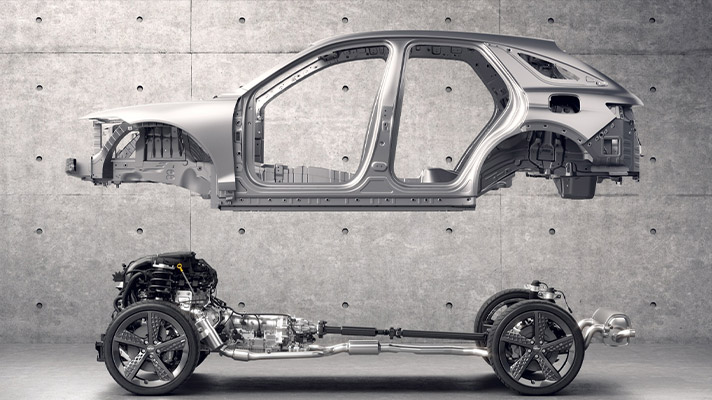
Thanks to 'Your Genesis', buyers can freely choose the engine, drivetrain, seat configuration, exterior color, wheels, interior design, and other optional packages to suit their lifestyle. Therefore, even if you purchase a low-level trim, you can choose the four-wheel-drive option separately. For example, when purchasing a Genesis G80, Your Genesis program allows you to select the engine type (gasoline 2.5T, 3.5T, and diesel 2.2) and then the type of drivetrain (electronic AWD, 2WD) as the first step, allowing you to choose a four-wheel drive before you select other convenience features. In other words, you can choose the four-wheel-drive while purchasing even the basic model.
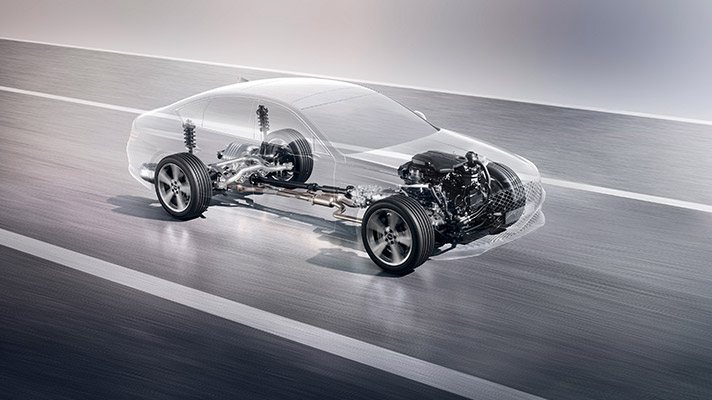
As above, Genesis' four-wheel-drive option can be selected at a reasonable price for all models and trims, making it the most favorite option for customers who purchase the Genesis. In particular, it is said to be highly satisfactory as it has been developed to exhibit optimal performance in the road environment in South Korea, where the climate and temperature of the four seasons are distinct, snow and rain are frequent, and there are many hilly roads and corners.
However, even if a four-wheel drive is applied, things still remain to be considered. Four-wheel drive excels at moving forward through the snow, but it is easy to slip when cornering or braking, just like any other front-wheel drive or rear-wheel drive. Therefore, it may lead to an accident if you enter a corner or increase your speed too much just because it feels easy to accelerate on snowy roads. This is the reason why you should change to winter tires if the temperature starts to drop after November. Keep in mind that four-wheel-drive is mainly capable of starting and accelerating on snowy roads, and it is still easy to slip regardless of the drivetrain when cornering or braking.


Ten Years of Genesis: A Journey Built Together
2025.11.27 12min read